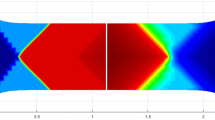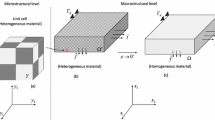Abstract
Stress gages, plane-shear gages, and three-element strain rosettes have long been used in experimental-mechanics investigations on isotropic materials. This paper generalizes these concepts for applications to fiber-reinforced composite materials. Also included for the first time are data-reduction equations whichexplicitly incorporate strain-gage transverse sensitivity.
Similar content being viewed by others
Abbreviations
- C :
-
stress/measured strain constant; see eqs (15), (23), and (26)
- E :
-
Young's modulus
- F :
-
gage factor
- G :
-
shear modulus
- K :
-
transverse-sensitivity factor of gage element
- Q ij :
-
plane-stress reduced elastic stiffnesses
- ΔR/R o :
-
relative change in gage electrical resistance
- ε:
-
actual normal strain
- ε′:
-
measured apparent normal strain
- ν:
-
Poisson's ratio (=negative of the transverse strain divided by the longitudinal strain when loaded uniaxially in longitudinal direction)
- γ xy :
-
shear strain associated with grid lines in x and y directions
- σ:
-
normal stress
- ϕ:
-
angular orientation of a gage element from a reference axis
- a, t :
-
axial and transverse with respect to gage-element axis
- i :
-
associated with manufacturer's gage calibration on isotropic material
- max :
-
maximum
- ss :
-
shear associated with directions x and y
- u :
-
uniaxial-loading case
- x,y :
-
associated with orthogonal reference directions (in fiber composite, x is the fiber direction)
- xx, yy :
-
associated with primary normal-stress stiffness
- xy :
-
associated with secondary (Poisson) normal-stress stiffness
- 1,2:
-
associated with gages elements 1 and 2
- 3, 3n :
-
associated with gage element 3 and direction normal to it
References
Williams, S.B., “The Dyadic Gage,”Proc. SESA,I (2),43–55 (1944).
Williams, S.B., “Strain-Responsive (Stress) Gage,“ U.S. Patent No. 2,592,223 (April 8, 1952).
Kern, R.E., “The Stress Gage,”Proc. SESA,IV (1),124–129 (1946).
Kern, R.E. andWilliams, S.B., “Stress Measurement by Electrical Means,”Elec. Eng. (Trans. Section),65 (3),100–107 (March1946).
Lissner, H.R. andPerry, C.C., “Conventional Wire Strain Gage Used as a Principal Stress Gage,”Proc. SESA,XIII (1),25–32 (1955).
Hines, F.F., “The Stress-Strain Gage,”Experimental Mechanics (Proc. 1st Inter. Cong. Exp. Mech., New York, 1961), ed. B.E. Rossi,Pergamon Press, New York, 237–253 (1963).
Perry, C.C., “Plane-Shear Measurement with Strain Gages,”Experimental Mechanics,9 (1),19N-22N (Jan.1969).
Baumberger, R. andHines, F., “Practical Reduction Formulas for Use on Bonded Wire Strain Gages in Two-Dimensional Stress Field,”Proc. SESA,II, (1),113–127 (1944).
Meier, J.H., “On the Transverse-strain Sensitivity of Foil Gages,”Experimental Mechanics,1 (7),39–40 (July1961).
Gu, W.-M., “A Simplified Method for Eliminating Error of Transverse Sensitivity of Strain Gage,”Experimental Mechanics,22 (1),16–18 (Jan.1982).
Whitney, J.M., Daniel, I.M. andPipes, R.B., “Experimental Mechanics of Fiber Reinforced Composite Materials,”SEM, Brookfield Center, CT (1982).
Tuttle, M.E. and Brinson, H.F., “Transverse Sensitivity Effects of Strain Gages on Orthotropic Composite Materials,” Proc. 1983 SESA Fall Meeting, Salt Lake City, UT, 6–10 (1984).
Tuttle, M.E. andBrinson, H.F., “Resistance-Foil Strain-Gage Technology as Applied to Composite Materials,”Experimental Mechanics,24 (1),54–65 (March1984).
“Strain Measurement on Composite Materials. Chapter 1—Some Fundamental Considerations,”Epsilonics, Measurements Group, Inc.,IV (1),10–11 (April 1984).
“Strain Measurement on Composite Materials, Chapter 2—Some Practical Considerations,”Epsilonics, Measurements Group, Inc.,IV (1),14–15 (Oct. 1984).
Sevenhuijsen, P.J., “Stress Gages,”Experimental Techniques,8 (5),26–27 (March1984).
Bert, C.W. andKumar, M., “Measurement of Bimodular Stress-Strain Behavior of Composities Using Liquid-Metal Strain Gages,”Experimental Techniques,6 (6),16–20 (Dec.1982).
Bert, C.W., “Experimental Characterization of Composites,” Structural Design and Analysis, Part II, ed. C.C. Chamis,Composite Materials, ed. L.J. Broutman and R.H. Krock,Academic Press, New York,8,ch. 9,73–133 (1975).
Author information
Authors and Affiliations
Rights and permissions
About this article
Cite this article
Bert, C.W. Normal and shear stress gages and rosettes for orthotropic composites. Experimental Mechanics 25, 288–293 (1985). https://doi.org/10.1007/BF02325099
Received:
Revised:
Issue Date:
DOI: https://doi.org/10.1007/BF02325099




